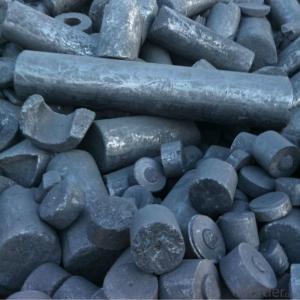Graphite Electrode Scrap high-purity as carbon additive and carburant
- Loading Port:
- Qingdao
- Payment Terms:
- TT OR LC
- Min Order Qty:
- 10 m.t
- Supply Capability:
- 5000000 m.t/month
OKorder Service Pledge
Quality Product, Order Online Tracking, Timely Delivery
OKorder Financial Service
Credit Rating, Credit Services, Credit Purchasing
You Might Also Like
Specifications:
F.C 98%min and 98.5%min, size: 100mm up
- Description & Application
Electrode block processing of carburant in steelmaking and casting, than ordinary recarburizer absorption rate is high, easy to melt, can efficiently improve the quality of products and reduce the cost.
- Technical Specification
F.C (min) |
| 98% |
S (max) |
| 0.05% |
ASH (max) |
| 1.00% |
Vm (max) |
| 1.00% |
H2O (max) |
| 0.50% |
SIZE |
| |




- Q: What is the carbon content of 45# steel?
- Between 0.42- and zero point five zero percent per cent
- Q: How does carbon affect food production?
- There are several ways in which carbon impacts food production. Firstly, carbon dioxide (CO2) plays a vital role in photosynthesis, the process by which plants convert sunlight into energy and produce oxygen. Insufficient levels of carbon dioxide hinder plant growth and food production. However, excessive carbon emissions from human activities, such as the burning of fossil fuels, have led to increased concentrations of CO2 in the atmosphere. Initially, this can stimulate plant growth, but without a proper balance of essential nutrients, it can result in nutrient imbalances and reduced crop quality. Secondly, carbon is a crucial element in soil organic matter, which is essential for soil fertility and health. Soil organic matter retains moisture, enhances soil structure, and provides a habitat for beneficial microorganisms. Higher carbon levels in the soil promote healthier plant growth, increase nutrient availability, and improve water-holding capacity. Unfortunately, unsustainable agricultural practices like excessive tilling and deforestation deplete soil carbon, leading to decreased fertility, erosion, and reduced food production. Moreover, the rise in carbon emissions has contributed to global climate change, resulting in extreme weather events such as droughts, floods, and heatwaves. These events have devastating consequences for food production. Droughts reduce water availability, making it difficult for crops to grow, while floods can wash away entire harvests. Heatwaves damage crops, reduce yields, and increase the prevalence of pests and diseases. Climate change also alters rainfall patterns, affecting planting and harvesting schedules and disrupting agricultural systems. Furthermore, carbon emissions contribute to the acidification of oceans. The increased CO2 in the atmosphere leads to higher levels of dissolved carbon dioxide in seawater, forming carbonic acid. This acidification disrupts marine ecosystems, affecting the food chain and impacting fish populations, which serve as a crucial protein source for many people. To mitigate the negative impacts of carbon on food production, it is essential to reduce carbon emissions and transition to more sustainable agricultural practices. This includes adopting climate-smart farming techniques like agroforestry, conservation agriculture, and organic farming. These practices promote carbon sequestration in soils, reduce greenhouse gas emissions, enhance biodiversity, and improve soil health. Additionally, investing in research and development of climate-resilient crop varieties and improved irrigation systems can help minimize the effects of climate change on food production.
- Q: How to identify a laptop shell is carbon fiber
- Carbon fiber, as its name suggests, is made from carbon fiber, so there are several characteristics. First, if it is not colored, you can see the obvious fiber. Second is black carbon color. And it's a lot more than ABS.
- Q: What is the chemical symbol for carbon?
- C is the designated chemical symbol for carbon.
- Q: What are the properties of activated carbon?
- Activated carbon is a highly porous material with a large surface area that allows it to adsorb or trap a wide range of organic and inorganic impurities from gases and liquids. It has a high adsorption capacity, excellent chemical stability, and is resistant to abrasion. Activated carbon is also known for its ability to remove odors, color, and taste from substances. Moreover, it can be easily regenerated and reused, making it a cost-effective and environmentally friendly solution for various purification processes.
- Q: Speak in detail! I am ~ carbon Roast Lamb Leg lamb chops lamb barbecue ah ~ ~ how to do with practice video line! And how do you bake the oven?
- Step 2: prepare garlic paste, starch paste, mixed evenly, with the barbecue. The purpose is to make the lamb roast outside tender, and not paste, garlic flavor rich, delicious, very delicious, this is a unique secret recipe, dedication. Step 3: students after adding charcoal, grill, the best 30 cm distance between the grill with charcoal, around to gather, the formation of hot absolute direction, to avoid heat loss. Lamb must be able to rack up and down around the inversion freely, to evenly bake. Bake for 7 minutes until the lamb cooked, mashed garlic paste to wipe, scorched yellow Maoyou creaking, sprinkle with pepper and natural. Time to master almost on the line. Because mutton has the distinction between the old lamb and the lamb, it is difficult to grasp the baking time. If you use a home electric oven, you'll need to marinate the mutton first. Methods: fresh meat (lean half) dice, into the pot, cumin, pepper, fennel, two, ginger,
- Q: How accurate is carbon dating?
- The scientific method known as carbon dating, or radiocarbon dating, is widely used to determine the age of organic materials that are up to 50,000 years old. It relies on measuring the ratio of radioactive carbon-14 (C-14) to stable carbon-12 (C-12) in a sample. Carbon dating has proven to be highly accurate, with a small margin of error. Its accuracy depends on factors such as the quality and preservation of the sample, the precision of measurement instruments, and understanding the carbon cycle in the past. However, carbon dating has limitations. It can only be used on organic materials that were once alive, so it is not applicable to dating inorganic materials like rocks or minerals. It is most effective for samples younger than 50,000 years old because the amount of C-14 decreases over time, making accurate measurement more challenging. To ensure accuracy, scientists often use multiple dating methods or cross-reference results with other independent techniques. This helps to verify the reliability of carbon dating and gain a more comprehensive understanding of the sample's age. Advancements in technology and calibration methods have improved the accuracy of carbon dating. For example, Accelerator Mass Spectrometry (AMS) allows for smaller sample sizes and greater measurement precision, reducing the margin of error. Calibration curves based on tree rings, or dendrochronology, also refine the accuracy of carbon dating. While carbon dating is highly reliable, it is important to recognize that no dating technique is perfect. All scientific dating methods have inherent limitations and uncertainties. However, with proper calibration and careful analysis, carbon dating remains one of the most accurate ways to determine the age of organic materials.
- Q: Who is the high carbon content of stainless steel and ordinary steel?
- Two, stainless steel according to different varieties, including carbon: 0--0.15%,Of which: 0--0.03% is called low carbon stainless steel.So, generally speaking, carbon steel has a higher carbon content.
- Q: How does carbon dioxide affect the Earth's atmosphere?
- Carbon dioxide (CO2) affects the Earth's atmosphere in several ways. First and foremost, it is a greenhouse gas, meaning it traps heat from the sun and prevents it from escaping back into space. This process, known as the greenhouse effect, plays a vital role in maintaining Earth's temperature range and making our planet habitable. However, excessive amounts of CO2 in the atmosphere can intensify the greenhouse effect, leading to global warming and climate change. Human activities, such as burning fossil fuels for energy and deforestation, have significantly increased the concentration of CO2 in the atmosphere since the industrial revolution. The increased levels of CO2 contribute to the rising global temperatures, melting polar ice caps, and changing weather patterns. These changes have severe consequences, including more frequent and intense heatwaves, droughts, floods, and storms. Additionally, CO2 absorption by the oceans leads to ocean acidification, which harms marine life and coral reefs. Furthermore, the increase in CO2 levels affects ecosystems and biodiversity. Plants use CO2 during photosynthesis, but excessive amounts can disrupt their growth and alter the balance of ecosystems. This disruption can have cascading effects on other organisms that rely on the affected plant species for food or shelter. Overall, the excess of carbon dioxide in the Earth's atmosphere is contributing to significant environmental changes and poses a threat to the stability of our planet. It is crucial to reduce CO2 emissions, promote sustainable practices, and develop alternative energy sources to mitigate the impacts of climate change and preserve the health of our atmosphere.
- Q: What are the effects of carbon emissions on the stability of river systems?
- River systems are significantly impacted by carbon emissions, which have far-reaching consequences. The release of carbon dioxide and other greenhouse gases into the atmosphere contributes to global warming, which in turn disrupts the hydrological cycle and alters river systems. One notable effect of carbon emissions on river systems is the rise in water temperature. As the planet heats up, rivers and other water bodies also become warmer. This increase in temperature has negative implications for aquatic ecosystems, as it reduces oxygen levels and makes many species more susceptible to diseases. Consequently, certain fish and other aquatic organisms may face decline or even extinction, disturbing the delicate equilibrium of river ecosystems. Moreover, carbon emissions play a role in the melting of glaciers and polar ice caps, resulting in higher volumes of water in rivers. The consequences of this can be observed in more frequent and severe flooding events within river systems. The excess water erodes riverbanks, leading to the loss of valuable land and infrastructure. It also forces communities residing along riverbanks to relocate, exacerbating social and economic issues. Additionally, carbon emissions contribute to the acidification of water bodies, including rivers. The increased levels of carbon dioxide in the atmosphere translate to higher concentrations of dissolved CO2 in rivers. When combined with water, this forms carbonic acid. The acidity of the water harms aquatic life, particularly organisms with shells or skeletons made of calcium carbonate, such as mollusks and certain types of plankton. Consequently, the disruption of the food chain has cascading effects on the entire river ecosystem. In conclusion, the impact of carbon emissions on the stability of river systems is profound. The rise in water temperatures, occurrences of flooding, and acidification present significant threats to the biodiversity and ecological balance of rivers. It is vital to reduce carbon emissions and adopt sustainable practices in order to safeguard the stability and well-being of these crucial ecosystems.
Send your message to us
Graphite Electrode Scrap high-purity as carbon additive and carburant
- Loading Port:
- Qingdao
- Payment Terms:
- TT OR LC
- Min Order Qty:
- 10 m.t
- Supply Capability:
- 5000000 m.t/month
OKorder Service Pledge
Quality Product, Order Online Tracking, Timely Delivery
OKorder Financial Service
Credit Rating, Credit Services, Credit Purchasing
Similar products
Hot products
Hot Searches
Related keywords



























